Welcome to the Craftsman Lawn Mower Owner’s Manual. This guide provides essential information for safe operation, maintenance, and troubleshooting. Read carefully before use.
1.1 Overview of the Manual’s Purpose and Structure
This manual is designed to guide you in safely operating and maintaining your Craftsman lawn mower. It covers essential topics such as safety precautions, assembly, operation, maintenance, and troubleshooting. The manual is structured into clear sections to help you navigate easily; Key areas include safety rules, operating instructions, regular maintenance schedules, and warranty information. By following this guide, you’ll ensure optimal performance and longevity of your mower. Reading the manual thoroughly before use is crucial for understanding proper procedures and safety measures. This comprehensive resource is your go-to guide for all aspects of your Craftsman lawn mower, from initial setup to long-term care.
1.2 Importance of Reading the Manual Before Operation
Reading this manual thoroughly before operating your Craftsman lawn mower is essential for safety, proper use, and maintenance. Understanding the controls, features, and safety precautions ensures you can operate the mower effectively and avoid potential hazards. Familiarize yourself with assembly steps, starting procedures, and routine maintenance tasks to keep your mower in optimal condition. Neglecting to read the manual may lead to improper use, which could result in accidents, equipment damage, or voiding the warranty. This guide provides detailed instructions to help you troubleshoot common issues, maintain performance, and ensure longevity of your lawn mower. Always prioritize safety and follow the recommendations outlined in this manual for the best experience with your Craftsman lawn mower.
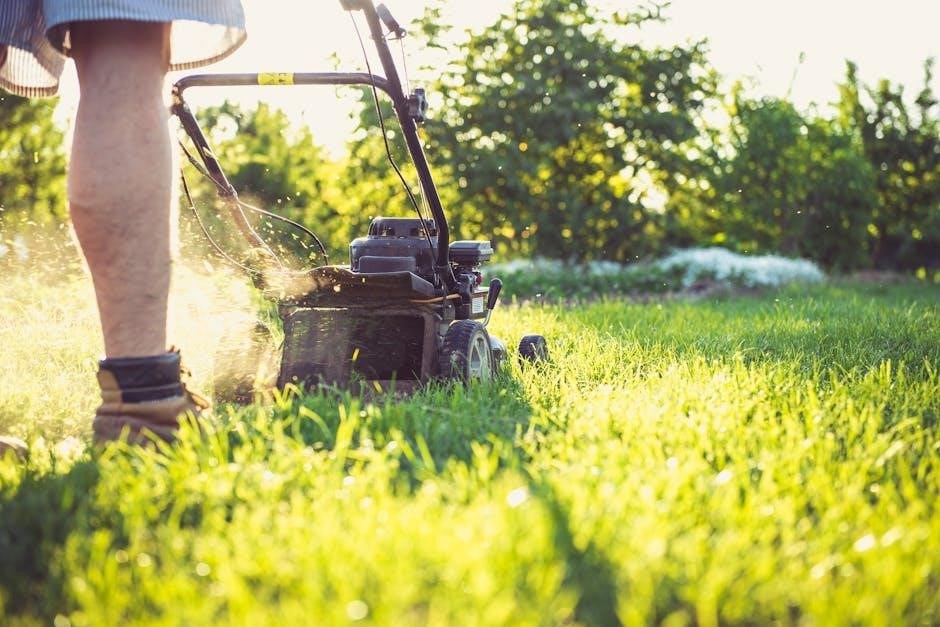
Safety Rules and Precautions
Adhere to safety guidelines to prevent accidents. Wear protective gear like gloves and goggles. Stay alert and keep children away while operating. Follow environmental precautions for responsible mowing.
2.1 General Safety Guidelines
Read the manual thoroughly before operating the mower. Always wear protective gear, including gloves and eye protection. Ensure the area is clear of obstacles and bystanders. Never leave the mower unattended while running. Keep children and pets at a safe distance. Be cautious of loose clothing or long hair that could get caught. Avoid mowing in reverse unless necessary, and never mow on steep slopes. Ensure the mower is in good working condition before use; Regularly inspect for damage or wear.Follow all safety precautions to minimize risks and ensure safe operation of your Craftsman lawn mower.
2.2 Personal Protective Equipment
Always wear appropriate protective gear while operating the lawn mower. This includes gloves to improve grip and prevent blisters, safety glasses or goggles to protect eyes from debris, and sturdy footwear to prevent injuries. Avoid loose clothing or jewelry that could get caught in moving parts. Hearing protection is also recommended, as mowers can generate high noise levels. Ensure all protective equipment fits properly and remains secure during operation. Failure to wear proper PPE can lead to serious injuries. Stay alert and maintain awareness of your surroundings while mowing. Regularly inspect your protective gear for damage or wear and replace as needed to ensure optimal protection.
2.3 Operating Precautions
Always ensure the grass catcher or discharge chute is securely in place before starting the mower. Operate the mower on stable, level ground, avoiding steep slopes or uneven terrain that could cause loss of control. Never mow in reverse unless absolutely necessary, and always be aware of obstacles or bystanders. Keep children and pets at a safe distance while mowing. Avoid wearing loose clothing or jewelry that could get caught in moving parts. Maintain a firm grip on the handles at all times. Slow down before turning and avoid sudden movements. Do not leave the mower unattended while it is running. Always turn off the engine and allow the blades to stop before leaving the mower or performing maintenance. Follow all safety guidelines outlined in this manual to ensure safe and effective operation.
2.4 Environmental Safety Considerations
Always prioritize environmental safety while operating your Craftsman lawn mower. Avoid discharging grass clippings or debris into waterways or storm drains, as this can harm aquatic ecosystems. Ensure proper disposal of used oil, fuel, and batteries by following local regulations and recycling guidelines. Never drain fluids or dispose of hazardous materials inappropriately, as this can contaminate soil and water. Keep the mower well-maintained to prevent leaks or emissions that could harm the environment. Use eco-friendly lubricants and fuels when possible. Regularly inspect and maintain the mower deck to minimize dust and debris dispersal. By adhering to these guidelines, you can help protect the environment while maintaining your lawn responsibly.

Assembly and Setup
Begin by carefully unboxing and inventorying all parts. Attach handles and accessories as outlined. Inspect for damage and position the mower on a level surface for first use.
3.1 Unboxing and Inventory of Parts
Start by carefully unboxing your Craftsman lawn mower and inspecting for any visible damage. Ensure all components are included, such as the mower deck, handlebars, grass catcher, and hardware. Refer to the parts list in the manual to verify completeness. Pay attention to any shipping braces or protective packaging that must be removed before assembly. If any parts are missing or damaged, contact customer support immediately. Properly inventorying ensures a smooth setup process. Always follow safety guidelines when handling sharp or heavy components. Familiarize yourself with each part’s purpose to avoid confusion during assembly. Double-check the inventory list before proceeding to ensure no essential items are overlooked. This step is crucial for safe and effective operation of your lawn mower. Follow the manual’s instructions carefully for accurate assembly.
3.2 Attaching Handles and Accessories
Attach the handlebars by aligning the bolts with the mower’s frame and tightening securely. Ensure all connections are stable and evenly tightened. Next, install any additional accessories like the grass catcher or mulch kit, following the manual’s instructions. For the grass catcher, hook it onto the mower’s designated clips, ensuring it’s securely locked in place. If using a mulch kit, attach the mulching blade and cover according to the manual. Double-check that all parts are properly aligned and tightened to avoid vibration or instability during operation. Refer to the torque specifications in the manual for precise tightening. Finally, test the handles and accessories by gently moving the mower to ensure everything is securely attached. Proper assembly ensures safe and efficient mowing.
3.3 Initial Inspection and Damage Check
Before first use, thoroughly inspect your Craftsman lawn mower for any damage or wear. Check the mower deck, blades, and handlebars for dents or bends. Ensure all bolts and screws are tightened to the torque specifications outlined in the manual. Inspect the tires for proper inflation and check for any signs of cracks or damage. Verify that the grass catcher, if included, is securely attached and free of tears. Look for any fluid leaks, such as oil or gas, and ensure the mower is on a level surface. If any damage is found, do not operate the mower until repairs are made. This inspection ensures safety and optimal performance. Always refer to the manual for specific guidance on inspection procedures.
3;4 Positioning the Mower for First Use
Before starting the engine, position the mower on a flat, stable surface away from slopes or uneven ground. Ensure the area is clear of debris, toys, or obstacles. Check that the mower is on a level surface to prevent uneven cutting or instability. Locate the oil fill cap and ensure it is securely tightened. Position the grass catcher or discharge chute according to the manual’s instructions. Familiarize yourself with the controls and ensure all safety features, such as the blade engagement lever, are in the correct position. Double-check that the mower is set to the proper height for your lawn type. Once positioned correctly, proceed with starting the engine as outlined in the manual.
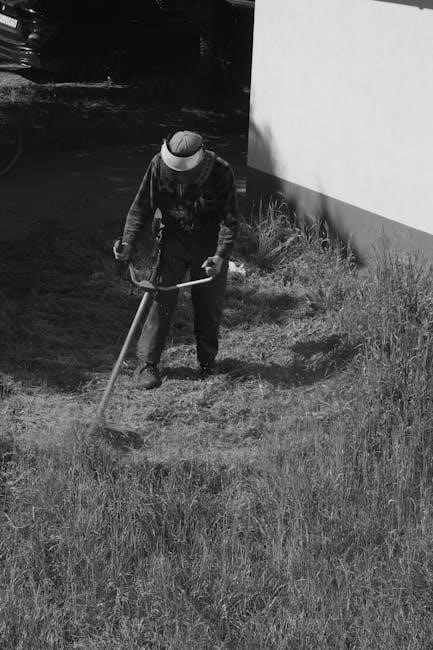
Operating Instructions
Master essential operating techniques for your Craftsman lawn mower, including starting the engine, using controls, and handling various terrain types safely and efficiently. Refer to sub-sections for detailed guidance.

4.1 Starting the Engine
Starting the engine of your Craftsman lawn mower involves a few simple steps. First, ensure the mower is on a level surface and the parking brake is engaged. Next, activate the choke to prime the engine. Pull the starter handle firmly to initiate the engine. If the engine does not start immediately, allow a few moments before retrying. Once running, gradually release the choke to ensure smooth operation. Always refer to the manual for specific starting procedures tailored to your model. Proper engine starting ensures optimal performance and longevity of your lawn mower. Follow these steps carefully to avoid unnecessary wear or potential damage. Safety precautions, such as ensuring no one is nearby, are crucial during this process. If issues arise, consult the troubleshooting section for guidance.
4.2 Basic Mowing Techniques
Mastering basic mowing techniques ensures efficient and even cutting. Start by mowing in a consistent pattern, such as straight lines or spiral motions, to cover the lawn systematically. Maintain a steady pace and avoid overlapping previously cut areas to prevent unevenness. Keep the mower at the recommended height for your grass type, adjusting as needed for different sections. When turning, slow down to maintain control and avoid tearing the grass. Regularly check the mower deck for debris to ensure optimal performance. For thicker or taller grass, raise the blade slightly to prevent clogging. Always mow with the discharge chute facing away from gardens or flower beds to protect plants. Refer to your manual for specific guidance tailored to your mower model. Proper technique enhances both lawn health and mower longevity. Practice these methods for a professional-looking finish every time.
4.3 Adjusting Mower Settings
Adjusting your Craftsman lawn mower settings ensures optimal performance. Start by setting the mowing height using the lever or knob, typically ranging from 1 to 4 inches. Choose the height based on grass type and season. For even cutting, maintain consistent height across the lawn. If your mower has adjustable handles, customize the ergonomics for comfort. The blade engagement lever controls cutting; ensure it’s disengaged when moving without mowing. Adjust the discharge chute direction to control grass clippings, directing them away from plants or gardens. Some models allow adjusting the deck pitch for even cutting. Always refer to your manual for specific instructions on adjusting these settings safely and effectively. Proper adjustments enhance cutting efficiency and lawn health.
4.4 Handling Different Terrain Types
Adapt your mowing technique to suit various terrain types for effective results. On flat surfaces, maintain a steady pace and keep the mower at the recommended height. For uneven terrain, slow down and raise the mowing deck slightly to avoid scalping the lawn. When mowing slopes, always go uphill to maintain traction and prevent the mower from slipping. For dense or tall grass, reduce your mowing width and overlap passes to ensure even cutting. Wet grass requires extra caution—slow down to avoid slipping and clog the mower. For tight spaces, use the mower’s turn radius to navigate around obstacles. Always keep the mower stable and avoid sudden movements, especially on inclines. Refer to your manual for specific settings and techniques tailored to your mower model.
4.5 Emptying the Grass Catcher
Regularly emptying the grass catcher ensures efficient mowing and prevents clogging. Always turn off the engine and wait for the blades to stop before removing the catcher. Wear gloves to protect your hands from sharp grass clippings. Locate the grass catcher, typically attached to the rear or side of the mower. Release the latch or lever to detach it. Carefully lift and pour the clippings into a compost bin or trash bag. Inspect the catcher for debris buildup and clean it with a brush or hose if necessary. Reattach the catcher securely to ensure proper operation. For optimal performance, empty the catcher when it’s two-thirds full. Refer to your manual for specific instructions tailored to your mower model.
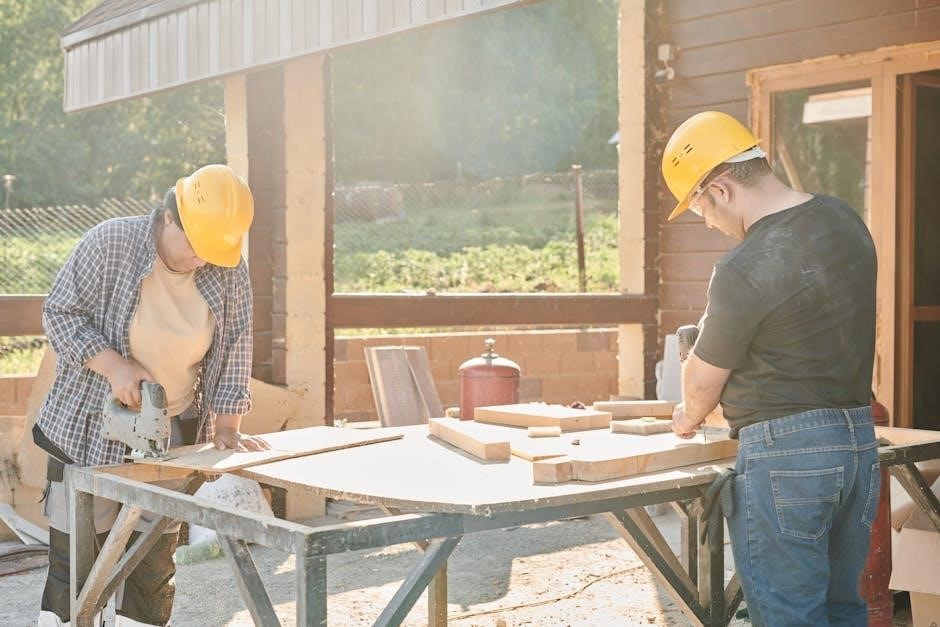
Maintenance and Upkeep
This section provides essential maintenance tasks to ensure your Craftsman lawn mower operates efficiently. Regular upkeep includes oil changes, blade sharpening, deck cleaning, and winter preparation to maintain performance and longevity.
5.1 Regular Maintenance Schedule
To keep your Craftsman lawn mower in optimal condition, follow a regular maintenance schedule. This includes checking and replacing the air filter every 25 hours of use, sharpening the mower blade every 50 hours, and lubricating moving parts seasonally. Additionally, drain and replace the engine oil every 50 hours or at the start of each mowing season. Inspect the mower deck for debris and clean it after each use to prevent rust and ensure even cutting. Check tire pressure monthly and maintain the recommended level. Regularly inspect the spark plug and replace it annually or as specified in the manual. Adhering to this schedule will extend the life of your mower and maintain its performance.
5.2 Oil and Fuel Requirements
For optimal performance, use the correct oil and fuel as specified in your Craftsman lawn mower manual. The recommended oil type is typically SAE 30 for most models. Always check the oil level before starting the engine and refill as needed, ensuring not to overfill. The oil capacity varies by model, so refer to your manual or the engine specifications for precise details. For fuel, use unleaded gasoline with an octane rating of 87 or higher. Avoid using ethanol-blended fuels, as they can damage the engine over time. Fresh fuel is essential; avoid using fuel that has been stored for more than 30 days. If storing the mower for an extended period, drain the fuel tank to prevent residue buildup. Proper oil and fuel maintenance ensures longevity and reliable operation of your mower.
5.3 Blade Sharpening and Replacement
Regular blade maintenance is crucial for optimal cutting performance. Sharpen the mower blade at least once a season or when it becomes dull. A dull blade tears grass, leaving it vulnerable to disease. To sharpen, remove the blade and use a file or grinder to maintain the original angle. Always wear gloves and safety glasses. If the blade is damaged or worn beyond sharpening, replace it with a genuine Craftsman blade. Ensure the new blade is properly balanced to avoid vibration. Tighten the blade bolt to the specified torque (typically 30-40 ft-lbs). A well-maintained blade ensures clean cuts and extends the mower’s lifespan.
5.4 Cleaning the Mower Deck
Regularly cleaning the mower deck is essential for maintaining your lawn mower’s performance and preventing rust or corrosion. After each use, remove grass clippings and debris from the deck using a stiff brush or water hose. For tougher buildup, mix a solution of mild detergent and water, apply it to the deck, and scrub with a stiff brush. Rinse thoroughly and dry the deck to prevent rust. Always disconnect the spark plug wire before cleaning to ensure safety. Cleaning the mower deck regularly helps improve airflow, reduces the risk of clogging, and ensures a cleaner cut. A clean deck also prevents grass from sticking and reduces wear on the mower’s components.
5.5 Winterizing the Mower
Winterizing your Craftsman lawn mower is essential to ensure it remains in good condition and operates effectively in the next mowing season. Start by draining the fuel tank or adding a fuel stabilizer to prevent degradation. Change the engine oil and filter to protect the engine from contaminants. Clean the mower deck thoroughly to remove grass clippings and debris, which can cause rust. Sharpen the blade and apply a rust-inhibiting coating. Store the mower in a dry, protected area, such as a garage or shed, to shield it from harsh weather. Disconnect the spark plug wire for safety. Proper winterization extends the lifespan of your mower and ensures it is ready for the next cutting season.
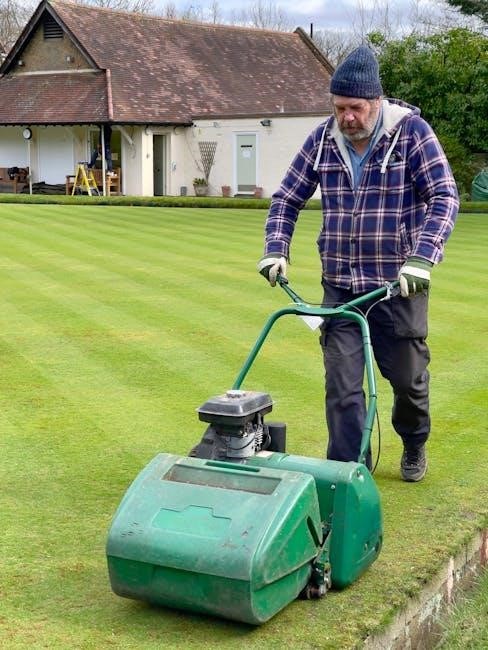
Troubleshooting Common Issues
This section helps diagnose and resolve common problems, such as engine issues, poor cutting performance, or vibration. Consult the manual for specific solutions or contact support.
6.1 Engine Not Starting
If the engine fails to start, check the fuel level and ensure the tank is not empty. Verify that the oil level is adequate, as low oil can prevent ignition. Inspect the air filter for cleanliness or blockages and clean or replace it if necessary. Ensure the choke is properly adjusted and that the throttle is in the correct position. Check for loose connections or damage to the spark plug wire and ensure the spark plug is in good condition. If the blade is engaged, disengage it before attempting to start the engine. Finally, ensure the ignition switch is functioning correctly. If issues persist, consult the troubleshooting guide or contact a certified service center for assistance.
6.2 Poor Cutting Performance
If your Craftsman lawn mower is not cutting evenly or leaving uneven grass, several factors could be contributing. Check if the mower blade is dull or damaged, as a sharp blade is essential for clean cuts. Inspect for debris or obstructions in the mowing deck, which can disrupt airflow and cutting efficiency. Ensure the blade is properly balanced and installed correctly. Uneven wear on the blade can also lead to poor performance. Additionally, verify that the mowing height is set appropriately for your grass type, as cutting too low or too high can result in uneven results. Finally, check the grass catcher for blockages or damage, as improper bagging can affect cutting performance. Addressing these issues should improve the mower’s cutting quality.
6.3 Vibration or Noise Issues
If your Craftsman lawn mower experiences excessive vibration or unusual noise during operation, several factors may be causing the issue. First, inspect the mower blade for balance and damage. An unbalanced or bent blade can create significant vibration. Check for loose bolts or screws, particularly on the blade and mower deck, as these can cause noise and instability. Additionally, worn or damaged pulleys or belts may contribute to vibration. Ensure the mower deck is clean and free of debris, as obstructions can cause uneven operation. If the noise persists, it may indicate a problem with the engine or transmission, requiring professional inspection. Addressing these issues will help restore smooth and quiet operation.
6.4 Leaks or Fluid Loss
If you notice fluid leaking from your Craftsman lawn mower or suspect fluid loss, immediate action is necessary. Check the oil and fuel lines for cracks, damage, or loose connections. Inspect the mower deck and engine for signs of leakage, such as oil droplets or stains. Tighten any loose bolts or fittings, and replace damaged hoses or seals. If the leak persists, turn off the engine and avoid operating the mower until the issue is resolved. For severe cases, consult a professional or contact Craftsman customer support. Regular maintenance and inspections can help prevent fluid loss and ensure safe, efficient operation. Always refer to the manual for specific guidance on handling fluid leaks.

Warranty and Support
Your Craftsman lawn mower is backed by a comprehensive warranty. Contact Sears for service or repairs. Details and support options are outlined in the manual.
7.1 Understanding the Warranty Terms
The warranty for your Craftsman lawn mower provides coverage for parts and labor against defects in materials and workmanship. The standard warranty period typically lasts for a specified number of years from the date of purchase. It is essential to review the terms and conditions to understand what is covered and what is excluded. Some warranties may offer extended coverage for specific components, such as the engine or deck. Proper maintenance and adherence to operational guidelines are often required to maintain warranty validity. For detailed information, refer to the warranty section in your owner’s manual or contact Sears customer support.
7.2 Contacting Customer Support
To contact Craftsman customer support, visit their official website or call the Sears Customer Service Center. Representatives are available to assist with warranty claims, troubleshooting, and repair inquiries. For efficient service, have your mower’s model number and purchase details ready. Online support resources, including FAQs and service locator tools, are also accessible. For parts or repairs, visit an authorized Sears Service Center. Ensure to follow the proper channels to avoid delays. Customer support is committed to resolving issues promptly and ensuring your satisfaction with your Craftsman lawn mower.

Additional Resources
For additional support, visit the official Craftsman website for online manuals, guides, and troubleshooting tips. Explore authorized service centers for professional assistance and genuine parts.
8.1 Online Manuals and Guides
Access online manuals and guides for your Craftsman lawn mower through the official Craftsman website. These resources include detailed operation guides, troubleshooting tips, and maintenance schedules. PDF versions of manuals are available for download, ensuring you always have the information you need. Additionally, the website offers repair manuals and parts diagrams to help with DIY fixes. For convenience, browse by model number or search specific topics like blade sharpening or winterizing. Visit the Parts and Services page for additional support and to find genuine replacement parts. These online tools empower you to maintain and repair your mower with confidence.
8.2 Repair and Service Centers
For professional assistance, locate authorized Craftsman repair and service centers near you. These centers offer expert maintenance, repairs, and genuine part replacements. Visit the Craftsman Service Center Locator on their official website to find the nearest facility. Trained technicians ensure your lawn mower is serviced to factory standards, extending its lifespan and performance. Additionally, Sears Service Centers, now part of the Craftsman network, provide warranty repairs and general maintenance. Always use genuine Craftsman parts for optimal functionality. Contact customer support for guidance or to schedule an appointment. Regular servicing at these centers ensures your mower remains in top condition, minimizing downtime and maintaining reliability.
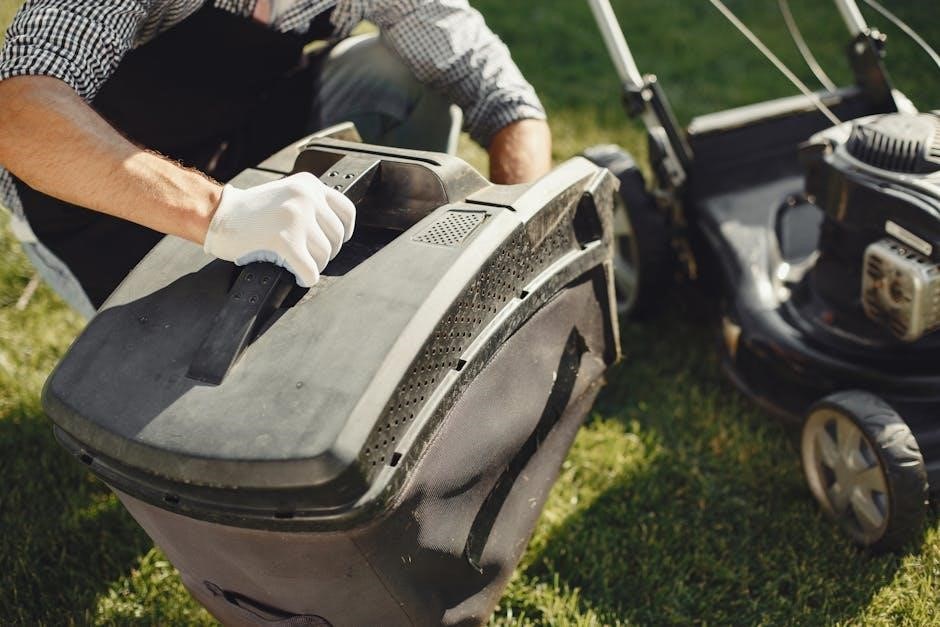
Frequently Asked Questions
Here are answers to common questions about your Craftsman lawn mower. For optimal performance, refer to the manual or contact customer support for further assistance.
- Why won’t my mower start? Check the fuel level, air filter, and spark plug. Ensure the choke is properly adjusted and the mower is on a level surface.
- How often should I sharpen the blade? Sharpen the blade every 20-25 hours of use or when cutting performance declines.
- Can I use synthetic oil? Yes, synthetic oil is recommended for better engine protection, especially in extreme temperatures.
- What if my mower leaks oil? Inspect for loose bolts or damaged seals. Contact a service center if issues persist.
- How do I winterize my mower? Drain the fuel, change the oil, and store in a dry place to prevent rust.
For more detailed solutions, consult the troubleshooting section or visit the Craftsman support website.

